Last updated on January 25th, 2023 at 01:11 am

Take Home Points
- Major non-Lyme tickborne diseases includes Anaplasmosis, Babesiosis, Ehrlichiosis, Tularemia, and Rocky Mountain Spotted Fever
- Non-Lyme tickborne disease can be a cause of serious complications or death
- Most tick-borne diseases are treated with doxycycline except for BABESIOSIS, TULAREMIA, AND TICK PARALYSIS
A 32 year old man presents to the ED with fevers and malaise after hiking and camping in Connecticut… do I even need to go into the rest of the history before your mind immediately jumps to “TICK BITE” and then makes the natural leap to looking for a characteristic targetoid erythematous rash?
No one would fault you for making the leap from outdoor recreation in a question stem or patient history to considering Lyme disease, I certainly did it, and the majority of the time, the CDC says you would be right to do so1:

Lyme disease makes up the majority of reported tickborne disease in the US, and although it overshadows the other tickborne diseases by a longshot, it’s important to consider the other causes of tickborne disease – if it’s not on your differential, you won’t diagnose it. So at the end of this article is a quick review on the non-Lyme tickborne diseases (with links below for quick access):
| Anaplasmosis | Babesiosis | Ehrlichiosis | Rocky Mountain Spotted Fever |
| Tick Paralysis | Tularemia | Other Tickborne Diseases |
But what do you really need to know when someone comes to the ED with a story concerning for a tick bite and nonspecific symptoms? Let’s break it down:
- The patient may bring you a picture of the tick or the tick itself – I am going to guess you are not a tick expert, but there are some smart people at the University of Rhode Island who are:
- You are not likely to be able to distinguish between the tick borne diseases based just on history and exam alone
- The exception to this is Lyme/STARI and Rocky Mountain Spotted Fever which show up with a classic rash (erythema migrans and a macular/petichial rash that travels centrally respectively), and Tick Paralysis
- Most tick borne disease is treated with doxycycline, remember the exceptions:
- Babesiosis – look for hemolysis on the labs, treat with atovaquone and azithromycin
- Tularemia – presents with local inflammation and regional lymphadenopathy; treat with ciprofloxacin for mild/moderate disease, streptomycin for severe disease
- Tick paralysis – presents with paralysis/weakness; remove the tick
- Viral tickborne diseases – this is not an exception, since these present much like Anaplasmosis/Ehrlichiosis, you would treat presumptively with doxycycline
Anaplasmosis
Anaplasmosis is caused by a bacteria that takes up residence inside our granulocytes (hence the prior name of the disease Human Granulocytic Anaplasmosis (HGA). This disease has been reported to be less severe than its sister Ehrlichiosis (0.3% case fatality vs 1-2.7%), though the presentations are similar, and since case fatality is increasing with more than 50% requiring hospitalization, if your clinical suspicion is high (history of being in an endemic area with flu like symptoms ±tick exposure) or moderate with labs suggestive of Anaplasmosis, treat with doxycycline.2,3
| The culprits | Anaplasma phagocytophilum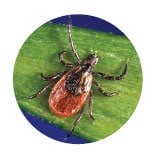 Blacklegged Tick Ixodes scapularis Blacklegged Tick Ixodes scapularis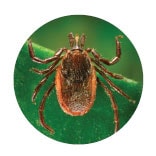 Western Blacklegged Tick Ixodes pacificus Western Blacklegged Tick Ixodes pacificus |
| Geography & season | Upper Midwest and Northeast US; Summer (June, July), second peak in October, November |
| Early presentation | NON-SPECIFIC: Fevers, chills, headache, myalgias, nausea/vomiting, loss of appetite, cough |
| Late presentation & severe illness | Respiratory failure, seizures, coma |
| Risk factors for severe illness | Elderly, immunosuppressed, immunocompromised (HIV) |
| Diagnosis | Clinical, ↓WBCs (with left shift), ↓Plts, transaminitis, ↑LDH, ↑Alk phos > PCR, serology >> blood smear |
| Treatment | Adults, children, pregnant patients: doxycycline (will also cover most other tickborne illnesses – not Babesiosis) |
Babesiosis
Babesiosis is one of the tick borne diseases that is NOT treated with doxycycline (!), and will turn up with abnormal labs later in the course. Unfortunately the classic “Maltese Cross” pattern that the parasite makes in erythrocytes is actually pretty rare (I doubt you are looking at your patients’ blood smear anyway). Much like encapsulated bacteria, Babesia can wreak havoc on asplenic patients. Complications arise in over half of patients admitted with severe Babesiosis, with the most common being ARDS; treat with azithromycin and atovaquone in nonpregnant adults with confirmed disease.4,5
| The culprits | Babesia microti  Blacklegged Tick Ixodes scapularis Blacklegged Tick Ixodes scapularis |
| Geography & season | Upper Midwest and Northeast US (especially New England); Spring and Summer (May-September, especially June) |
| Early presentation | Can be ASYMPTOMATIC, NON-SPECIFIC: Fevers, chills, sweats, headache, myalgias, nausea/vomiting, loss of appetite, cough |
| Late presentation & severe illness | Nausea, vomiting, diarrhea, pulmonary edema, ARDS, splenic rupture/infarct, CHF, renal failure, DIC |
| Risk factors for severe illness | Elderly, asplenia, immunosuppressed, immunocompromised (HIV) |
| Diagnosis | Hemolytic anemia (↓H/H, ↓haptoglobin, ↑LDH), transaminitis, thick/thin blood smear (rare to see the classic “Maltese cross”), PCR > serology |
| Treatment | Adults: azithromycin & atovaquone, Pregnant: clindamycin plus quinine, higher risk of relapse in immunocompromised |
Ehrlichiosis
Ehrlichiosis leads to more serious complications compared with its relative Anaplasmosis. Case fatality is increasing, 1-2.7% at the time of writing, with more than 50% requiring hospitalization, if your clinical suspicion is high (history of being in an endemic area with flu like symptoms ±tick exposure), or moderate with labs suggestive of Ehrlichiosis, treat with doxycycline.3,6
| The culprits | Ehrlichia chaffeensis, E. ewingii, or E. muris Blacklegged Tick Ixodes scapularis Blacklegged Tick Ixodes scapularis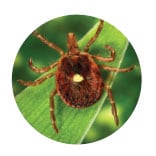 Lone Star Tick Amblyomma americanum Lone Star Tick Amblyomma americanum |
| Geography & season | Southeastern and South central US (NY, NC, AR, MO); Summer (June, July) |
| Early presentation | NON-SPECIFIC: Fevers, chills, headache, myalgias, nausea/vomiting, loss of appetite, cough |
| Late presentation & severe illness | Meningoencephalitis/AMS, respiratory failure, seizures, coma |
| Risk factors for severe illness | Elderly, immunosuppressed, immunocompromised (HIV) |
| Diagnosis | Clinical, ↓WBCs (with left shift), ↓Plts, transaminitis, ↑LDH, ↑Alk phos, CSF lymphocytic pleocytosis and elevated CSF protein levels > PCR, serology >> blood smear |
| Treatment | Adults, children, pregnant patients: doxycycline (will also cover most other tickborne illnesses – not Babesiosis) |
Rocky Mountain Spotted Fever
Though initially presenting with nonspecific symptoms Rocky Mountain Spotted Fever (RMSF) gives itself up with its characteristic rash which starts on the extremities and makes its way towards the trunk/head. The primary cause of severe disease is delay in treatment, which is likely secondary to to delay in diagnosis; don’t wait for the rash to develop – if you have strong clinical suspicion, treat with doxycycline.7,8
| The culprits | Rickettsia rickettsii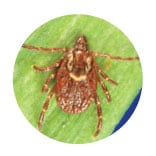 American Dog Tick Dermacentor variabilis, D. similis American Dog Tick Dermacentor variabilis, D. similis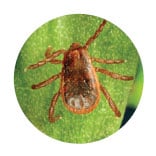 Brown Dog Tick Rhipicephalus sanguineus Brown Dog Tick Rhipicephalus sanguineus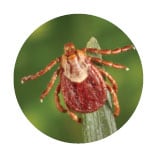 Rocky Mountain Wood Tick Dermacentor andersoni Rocky Mountain Wood Tick Dermacentor andersoni |
| Geography & season | Mid/South Atlantic & South central US (AR, MO, NC, TN, VA); Summer (June/July) – communities with free-roaming dogs; NOT in the Rocky Mountains region |
| Early presentation | NONSPECIFIC: Fever, headache, malaise, myalgias, arthralgias, abdominal pain, pedal edema, confusion, conjunctival erythema RASH on day 2-5 (macular blanching erythematous & peripheral → petechial & central)* 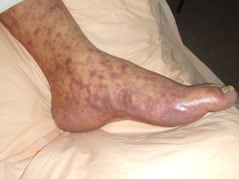 |
| Late presentation & severe illness | Meningoencephalitis, respiratory distress/ARDS, cardiac arrhythmias, coagulopathy, GI bleed, skin necrosis |
| Risk factors for severe illness | Delayed diagnosis/treatment, <4 years old, elderly, immunocompromise, male, chronic alcohol abuse, G6PD deficiency |
| Diagnosis | Clinical > ↓Plts, serology/PCR >> skin biopsy |
| Treatment | Adults, children, pregnant patients: Doxycycline (will also cover most other tickborne illnesses – not Babesiosis) |
Tick Paralysis
Tick paralysis is terrifying because it is rarely on our differential when we are seeing patients with weakness or abnormal neurological exam findings in the ED. Our go to are central causes of the presentation, and as you can see below, not considering this diagnosis can be fatal due to eventual respiratory paralysis. The cherry on top of this disease is its frustratingly simple treatment: remove the tick.9
| The culprits | Neurotoxins in tick saliva Over 40 species can cause tick paralysis Most cases caused by Rocky Mountain Wood Tick Dermacentor andersoni and American Dog Tick Dermacentor variabilis |
| Geography & season | Low incidence = poor data on geographic distribution or seasonality (likely warmer months) |
| Early presentation | Paresthesias, fatigue/weakness, irritability, muscle pain, absent deep tendon reflexes all over hours to few days; fever is ABSENT |
| Late presentation & severe illness | Unsteady gait/ataxia, ascending paralysis, respiratory paralysis |
| Risk factors for severe illness | Delay in diagnosis/not considering diagnosis |
| Diagnosis | Clinical (find the tick) |
| Treatment | Remove the tick, improvement over hours (weakness from some ticks may worsen 24-48 hrs post removal) |
Tularemia
Yes tularemia, although it is rare, can be transmitted from animals to humans via tick bite. This is a difficult diagnosis to make, not only are the initial symptoms nonspecific, making putting this disease on your differential difficult, but Francisella tularensis is difficult to grow in cultures. Mortality rates have trended down, now <5%. Unless your index of suspicion is high (tick bite and weeks-months of symptoms), treatment is likely going to be started by the inpatient team or primary care doctor.10,11
| The culprits | Francisella tularensis Lone Star Tick Amblyomma americanum Lone Star Tick Amblyomma americanum  American Dog Tick Dermacentor variabilis, D. similis American Dog Tick Dermacentor variabilis, D. similis  Rocky Mountain Wood Tick Dermacentor andersoni Rocky Mountain Wood Tick Dermacentor andersoni |
| Geography & season | South central United States, the Pacific Northwest, and parts of Massachusetts; Summer/warmer months (May-August) |
| Early presentation | NONSPECIFIC: fever, malaise, anorexia, headache Dependent on inoculation site but usually accompanied by regional lymphadenopathy – skin ulcers, eye irritation/inflammation, sore throat, cough, chest pain, dyspnea |
| Late presentation & severe illness | Prolonged fever, weight loss, adenopathy, weakness/fatigue lasting weeks-months, can progress to sepsis, renal failure, rhabdomyolysis, and hepatitis |
| Diagnosis | Clinical, Serology, PCR, culture |
| Treatment | Severe illness: streptomycin or gentamicin (aminoglycosides) Mild or moderate: Adults: Ciprofloxacin (fluoroquinolones); Children: Gentamicin |
Other Tickborne Diseases
Borrelia miyamotoi
Detected in blacklegged ticks and Western blacklegged ticks, this disease presents similarly to Anaplasmosis/Ehrlichiosis with nonspecific symptoms. PCR and serology is available, and the CDC in partnership with state health departments helps monitor B. miyamotoi infections. Treated with 2-4 weeks of doxycycline.12
Bourbon virus
If the virus is made anywhere other than Kentucky, it would be called whiskey virus.This is another tickborne disease with nonspecific symptoms, although it presents with leukopenia and thrombocytopenia similar to Anaplasmosis/Ehrlichiosis. Bourbon virus is relatively new, so time will tell on what diagnostics will be available. Unlike those Anaplasmosis and Ehrlichiosis, Bourbon virus is not treated with doxycycline (supportive care is the official answer), though given the similarity in presentation, these are patients who will likely be treated with the antibiotic.13
Colorado tick fever
This is a viral tickborne disease with nonspecific symptoms (half of patients had a biphasic fever) though some patients had a rash. Most patients had self limited mild disease and recovered, with some experiencing weakness/fatigue for several weeks; in rare cases there was stiff neck and confusion. Similar to Bourbon virus, given the similarity of presentation to Anaplasmosis/Ehrlichiosis, these patients will likely be treated with doxycycline, though the official answer is supportive care only.14
Heartland virus
This is another viral tickborne disease with nonspecific symptoms though the CDC specifically states that it may be accompanied by some mild leukopenia, thrombocytopenia, and transaminitis. It even goes as far to state that it presents similarly to Anaplasmosis/Ehrlichiosis. Once again, supportive care is the official answer for treatment, but given the similarity to the presentation to the aforementioned diseases these patients will likely receive doxycycline.15
Powassan disease
Another viral tickborne illness that seems to be increasing in cases reported in the northeast and Great Lakes regions of the US. Initial presentation is nonspecific, though this virus can cause more severe illness including meningitis/encephalitis, with as many as 1 out of 10 people with severe illness dying, and half of people who survive having long-term issues with headaches, loss of muscle mass and strength, and memory. Diagnose with serology or PCR and the treatment is supportive. 16
Other Spotted Fever Group Rickettsioses
There actually more Rickettsia species that cause different spotted fevers, though they present similarly with a dark eschar at the site of the bite, nonspecific symptoms, and then a rash. R. parkeri rickettsiosis, Pacific Coast tick fever (Rickettsia species 364D), and rickettsialpox (R. akari) are all less severe than Rocky Mountain spotted fever, but difficult to distinguish early on in the disease course – which is perfectly fine since they are all treated with doxycycline.17
STARI (Southern tick-associated rash illness)
The aptly named “STARI” is caused by a bite from the Lone Star tick which causes a rash that appears strikingly similar to the erythema migrans from Lyme fame. The cause of STARI isn’t known, nor is whether antibiotics are beneficial or necessary; but it looks like Lyme – treat with doxycycline.18
Tickborne relapsing fever (TBRF)
Defined by recurrent bouts of nonspecific symptoms (fever, headache, myalgias/arthralgias, nausea), TBRF is linked to the Western US and usually sleeping in “rustic, rodent-infested cabins in the mountains”, unless you’re in Texas, in which case it’s linked to cave exposures. These bouts of symptoms tend to last about 3 days and resolve for about one week before recurring in a similar cycle. It’s caused by a Borellia species and the spirochete can be seen in the blood smear, and you can also get serology or culture to confirm. Treat with doxycycline, though if your patient has CNS involvement or is pregnant, ceftriaxone can be used. Watch for Jarisch-Herxheimer reaction in the first 4 hours after initiating antibiotics (worsening of symptoms secondary to release of toxins/cytokines from dying bacteria).19
Cite this post: Arman Hussain, MD. “Tick Talk: It’s Not All Lyme Disease”. GW EM Blog. January 14, 2023. Available at: https://gwemblog.com/non-lyme-tick-diseases/.
Related Posts:
rMETRIQ Score: 17/21
References
- 1.Centers for Disease Control and Prevention. Tickborne Disease Surveillance Data Summary. Centers for Disease Control and Prevention. Published August 11, 2022. Accessed January 13, 2023. https://www.cdc.gov/ticks/data-summary/index.html
- 2.Centers for Disease Control and Prevention. Anaplasmosis. Centers for Disease Control and Prevention. Published May 9, 2022. Accessed January 13, 2023. https://www.cdc.gov/anaplasmosis/
- 3.McClain, MD, PhD K, Eckstein, MD O. Human ehrlichiosis and anaplasmosis. UpToDate. Published March 21, 2022. Accessed January 13, 2023. https://www.uptodate.com/contents/human-ehrlichiosis-and-anaplasmosis
- 4.Centers for Disease Control and Prevention. CDC – Babesiosis. Centers for Disease Control and Prevention. Published March 31, 2020. Accessed January 14, 2023. https://www.cdc.gov/parasites/babesiosis/
- 5.Krause, MD P, Vannier, PhD EG. Babesiosis: Treatment and prevention. UpToDate. Published October 25, 2022. Accessed January 14, 2023. https://www.uptodate.com/contents/babesiosis-treatment-and-prevention
- 6.Centers for Disease Control and Prevention. Ehrlichiosis. Centers for Disease Control and Prevention. Published May 9, 2022. Accessed January 14, 2023. https://www.cdc.gov/ehrlichiosis/index.html
- 7.Sexton, MD DJ, McClain, MD, PhD MT. Clinical manifestations and diagnosis of Rocky Mountain spotted fever. UpToDate. Published September 15, 2022. Accessed January 14, 2023. https://www.uptodate.com/contents/clinical-manifestations-and-diagnosis-of-rocky-mountain-spotted-fever
- 8.Centers for Disease Control and Prevention. Rocky Mountain Spotted Fever (RMSF). Centers for Disease Control and Prevention. Published May 7, 2019. Accessed January 14, 2023. https://www.cdc.gov/rmsf/index.html
- 9.Sexton, MD DJ. Tick paralysis. UpToDate. Published April 1, 2022. Accessed January 14, 2023. https://www.uptodate.com/contents/tick-paralysis
- 10.Centers for Disease Control and Prevention. Tularemia. Centers for Disease Control and Prevention. Published December 13, 2018. Accessed January 14, 2023. https://www.cdc.gov/tularemia/index.html
- 11.Penn, MD RL. Tularemia: Clinical manifestations, diagnosis, treatment, and prevention. UpToDate. Published June 28, 2022. Accessed January 14, 2023. https://www.uptodate.com/contents/tularemia-clinical-manifestations-diagnosis-treatment-and-prevention
- 12.Molloy PJ, Telford SR III, Chowdri HR, et al. Borrelia miyamotoi Disease in the Northeastern United States. Ann Intern Med. Published online July 21, 2015:91-98. doi:10.7326/m15-0333
- 13.Centers for Disease Control and Prevention. Bourbon Virus. Centers for Disease Control and Prevention. Published September 20, 2022. Accessed January 14, 2023. https://www.cdc.gov/bourbon-virus/index.html
- 14.Centers for Disease Control and Prevention. Colorado Tick Fever. Centers for Disease Control and Prevention. Published September 20, 2022. Accessed January 14, 2023. https://www.cdc.gov/coloradotickfever/
- 15.Centers for Disease Control and Prevention. Heartland Virus. Centers for Disease Control and Prevention. Published September 20, 2022. Accessed January 14, 2023. cdc.gov/heartland-virus/index.html?CDC_AA_refVal=https%3A%2F%2Fwww.cdc.gov%2Fncezid%2Fdvbd%2Fheartland%2Findex.html
- 16.Centers for Disease Control and Prevention . Powassan Virus. Centers for Disease Control and Prevention . Published September 20, 2022. Accessed January 14, 2023. https://www.cdc.gov/powassan/
- 17.Centers for Disease Control and Prevention. Other Spotted Fever Group Rickettsioses. Centers for Disease Control and Prevention. Published January 18, 2019. Accessed January 14, 2023. https://www.cdc.gov/otherspottedfever/
- 18.Centers for Disease Control and Prevention. Southern Tick-Associated Rash Illness. Centers for Disease Control and Prevention. Published September 25, 2019. Accessed January 14, 2023. https://www.cdc.gov/stari/
- 19.Centers for Disease Control and Prevention. Relapsing Fever. Centers for Disease Control and Prevention. Published September 10, 2015. Accessed January 14, 2023. https://www.cdc.gov/relapsing-fever/

